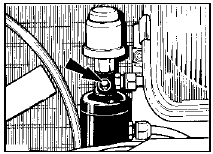Air conditioner refridgerant charge check (Every 12 000 miles (20 000 km) or 12 months)
1 If applicable, remove the radiator grille being careful not to damage the condenser fins.
2 Check the refrigerant charge as follows.
The engine should be cold and the ambient temperature should be between 64° and 77°F (18° and 25°C).
3 Start the engine and allow it to idle.
Observe the refrigerant sight glass (see illustration)

26.3 Air conditioning system refrigerant sight glass (arrowed)
and have an assistant switch on the air conditioning to fan speed III. A few bubbles should be seen in the sight glass as the system starts up, but all bubbles should disappear within 10 seconds. Persistent bubbles, or no bubbles at all, mean that the refrigerant charge is low. Switch off the system immediately if the charge is low and do not use it again until it has been recharged.
4 Inspect the refrigerant pipes, hoses and unions for security and good condition. Refit the radiator grille.
5 The air conditioning system will lose a proportion of its charge through normal seepage typically up to 100 g (4 oz) per year - so it is as well to regard periodic recharging as a maintenance operation.
See also:
Fuel pump - cleaning
Note: Refer to the warning at the end of
Section 1 before proceeding.
1 On certain early models the fuel pump has
a detachable cover allowing access to the
internal filter for cleaning. If this ty ...
Engine mountings - renewal
1 The engine mountings incorporate
hydraulic dampers and must be renewed if
excessive engine movement is evident.
2 Working in the engine compartment,
unscrew the central nuts securing the engine
...
Horn switch assembly - removal and refitting
1 Disconnect the battery negative lead.
Switch
Models up to 1987
2 Pull the trim insert from the centre of the
steering wheel, and disconnect the lead from
the horn push.
3 Disconnect the two le ...
